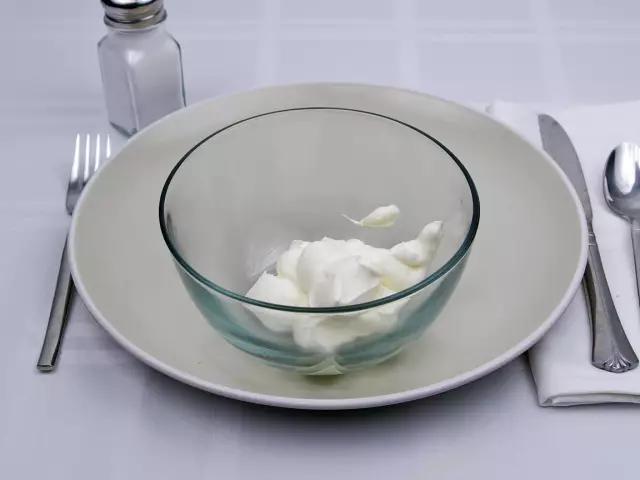- Author Rachel Wainwright [email protected].
- Public 2023-12-15 07:39.
- Last modified 2025-11-02 20:14.
Solantra
Solantra: instructions for use and reviews
- 1. Release form and composition
- 2. Pharmacological properties
- 3. Indications for use
- 4. Contraindications
- 5. Method of application and dosage
- 6. Side effects
- 7. Overdose
- 8. Special instructions
- 9. Application during pregnancy and lactation
- 10. Use in childhood
- 11. In case of impaired renal function
- 12. For violations of liver function
- 13. Use in the elderly
- 14. Drug interactions
- 15. Analogs
- 16. Terms and conditions of storage
- 17. Terms of dispensing from pharmacies
- 18. Reviews
- 19. Price in pharmacies
Latin name: Solantra
ATX code: D11AX22
Active ingredient: Ivermectin (Ivermectin)
Producer: Laboratoires Galderma (France)
Description and photo update: 2019-30-12
Prices in pharmacies: from 1078 rubles.
Buy

Solantra is a dermatotropic antimicrobial and antiprotozoal agent for external use.
Release form and composition
The drug is produced in the form of a cream for external use 1%: from white to light yellow (in a cardboard box, instructions for the use of Solantra and 1 laminated tube containing 15 or 30 g of cream).
Composition of the preparation per 1 g:
- active substance: ivermectin - 10 mg;
- excipients: propylene glycol, methyl parahydroxybenzoate, citric acid monohydrate, carbomer copolymer type B, isopropyl palmitate, macrogola cetostearyl ether, propyl parahydroxybenzoate, sorbitan stearate, disodium edetate, glyceryl alcohol solution with 20 Cst viscosity %, cetyl alcohol, purified water.
Pharmacological properties
Pharmacodynamics
The active ingredient in Solantra is ivermectin, a medicinal substance from the avermectin group with anti-inflammatory activity. The mechanism of action is due to its ability to suppress the production of inflammatory cytokines induced by lipopolysaccharides.
The effect of the drug when applied externally was observed in models of inflammatory skin processes in animals.
Another property of ivermectin is to cause the death of parasites, which is mainly due to selective binding and high affinity for glutamate-regulated chlorine channels located in muscle and nerve cells of invertebrates.
In inflammatory lesions caused by rosacea, the mechanism of action of the drug has not been established. However, it may be related to both the anti-inflammatory properties of ivermectin and its ability to kill Demodex mites that cause skin inflammation.
Pharmacokinetics
In a clinical study, the absorption of the active substance was assessed when Solantra was used in the maximum allowable dose in adult patients with severe papulopustular rosacea. After 2 weeks of treatment at steady state, the highest drug concentrations (C max) in blood plasma averaged 2.1 ± 1.0 ng / ml (range 0.7-4.0 ng / ml) and were observed after 10 ± 8 hours. The highest average area under the pharmacokinetic curve (AUC) was average 36 ± 16 ng × h / ml (range 14-75 ng × h / ml). The systemic exposure of the substance reached a plateau under equilibrium conditions by the end of the 2nd week of treatment. With more prolonged use of Solantra, the systemic exposure parameter did not change. At equilibrium concentration, the level of systemic exposure was lower than after a single oral ivermectin 6 mg dose in healthy volunteers.
In vitro, ivermectin binds to plasma proteins (mainly albumin) by more than 99%. No significant binding was observed with erythrocytes.
According to in vitro studies, when using human liver microsomes and recombinant CYP450 enzymes, ivermectin is metabolized mainly under the influence of CYP3A4 inhibitors.
In the same studies, it was found that the drug is not able to inhibit CYP450 isoenzymes 2D6, 2C9, 2B6, 1A2, 4A11, 2C19, 2A6, 2E1, 3A4 and 2C8.
Ivermectin in the culture of human hepatocytes does not cause the expression of CYP450 enzymes (2C9, 1A2, 3A4, 2B6).
In clinical studies of the pharmacokinetics of ivermectin after the application of Solantra in the maximum allowable dose, two of its metabolites were identified - 4a-hydroxy ivermectin and 3'-O-demethyl ivermectin. Like ivermectin, its metabolites reached an equilibrium state by the end of the 2nd week of treatment. exposure (C max and AUC) in equilibrium after external use is significantly lower than in patients who received the drug inside.
After applying the maximum allowable dose of Solantra once a day for 28 days, the average half-life (T 1/2) was 6 days, or 145 hours (in the range from 92 to 238 hours). Excretion depends on the degree of absorption after external use of the cream.
In patients with functional impairment of the kidneys and liver, the pharmacokinetics of ivermectin have not been studied.
Indications for use
Solantra is used to treat inflammatory skin lesions in rosacea (papulopustular therapy).
Contraindications
Absolute:
- age up to 18 years;
- pregnancy and lactation;
- hypersensitivity to any component in the cream.
Solantra should be used with caution in patients with impaired liver function.
Solantra, instructions for use: method and dosage
Solantra cream is intended exclusively for external use.
A small amount (about the size of a pea) is applied to the skin of all five areas of the face: chin, cheeks, nose, forehead. Then spread in a thin layer over the entire face, avoiding contact with lips, mucous membranes of the mouth and eyes.
Frequency rate of application - 1 time per day. The duration of treatment is determined individually, it can be up to 4 months. If necessary, repeat the course.
If no improvement is noted after 3 months, further use of the drug is inappropriate.
Side effects
Solantra can cause the following side effects from the skin and subcutaneous tissues (the frequency of their development is classified as follows: from ≥ 1/100 to <1/10 - often, from ≥ 1/1000 to <1/100 - infrequently, and also unknown frequency when it cannot be estimated based on available data):
- often: burning sensation of the skin;
- infrequently: dryness and irritation of the skin, itching;
- unknown frequency *: allergic reactions, contact dermatitis, erythema.
* Data obtained in the course of post-marketing research.
In most cases, frequent and infrequent adverse events are mild to moderate, and gradually diminish with continued treatment.
There were no significant differences in the safety profile of Solantra in patients aged 18-65 years and over 65 years.
Overdose
There have been no reports of cases of overdose of Solantra.
In case of accidental or excessive use of veterinary dosage forms of ivermectin by people (body application, inhalation, ingestion, parenteral administration), the most common negative symptoms such as dizziness, headache, facial edema and / or eyelid edema, asthenia, skin rash, diarrhea, nausea, vomiting. The following reactions have also been reported: urticaria, contact dermatitis, paresthesia, shortness of breath, ataxia, abdominal pain, convulsions.
If you accidentally swallow Solantra cream, it is recommended to induce vomiting and / or urgently flush the stomach, then take a laxative and take other measures to prevent or eliminate intoxication. The measures are symptomatic in nature and include parenteral administration of electrolytes and fluids, taking vasopressors (in case of a pronounced decrease in blood pressure), and, if necessary, breathing support (oxygen supply or artificial ventilation).
special instructions
Solantra cream contains auxiliary components that can cause local skin reactions, for example, contact dermatitis (stearyl alcohol, cetyl alcohol), skin irritation (propylene glycol), allergic reactions, including delayed-type reactions (propyl parahydroxybenzoate, methyl parahydroxybenzoate).
Hands should be washed thoroughly after each application of the cream. Cosmetic products are allowed to be used after the product has dried.
The drug can only be applied to the skin of the face.
Influence on the ability to drive vehicles and complex mechanisms
The components in the Solantra cream have no effect at all or to a small extent affect the ability to concentrate and the speed of reactions.
Application during pregnancy and lactation
In studies on rats and rabbits regarding the reproductive toxicity of oral forms of the drug, it was found that ivermectin has teratogenic potential. However, when it is used externally in recommended doses, the development of fetotoxicity in humans is unlikely. Nevertheless, in pregnant women, studies on the effect of the drug have not been carried out, therefore the appointment of Solantra is not recommended.
After taking oral forms of preparations containing low concentrations of ivermectin, it is excreted in breast milk. Similar properties have not been studied in humans when applied externally. However, the results of animal studies suggest that with external use of the drug, the active substance penetrates into the mother's milk, which does not exclude the risk of side effects in an infant. In this regard, if treatment with Solantra cream is necessary during lactation, it is recommended to stop breastfeeding.
Pediatric use
Solantra is not prescribed to patients under 18 years of age, since the efficacy and safety of ivermectin has not been studied in this age group.
With impaired renal function
No dose adjustment is required.
For violations of liver function
In case of existing functional disorders of the liver, Solantra should be used with caution.
Use in the elderly
No dose adjustment is required.
Drug interactions
Studies on the possible interaction of Solantra with other medicinal substances have not been conducted.
The combined use of ivermectin with other external and systemic drugs for the treatment of rosacea has not been studied.
Since CYP3A4 inhibitors are predominantly involved in the metabolism of ivermectin, caution should be exercised when using Solantra simultaneously with powerful inhibitors of this isoenzyme - they can significantly increase the plasma concentration of the drug.
Analogs
Solantra's analogues are Azelik, Skinoren, Retinoic ointment, Sulfodecortem, Isotretinoin, Tretinoin, Betamethasone, etc.
Terms and conditions of storage
Store at temperatures up to 30 ° C out of reach of children.
Shelf life is 2 years.
Terms of dispensing from pharmacies
Dispensed by prescription.
Reviews about Solantra
Patients leave mostly positive reviews about Solantra. High efficiency of the preparation, light and pleasant texture of the cream, neutral smell, economical consumption are noted. They attribute only the high cost of the drug to a disadvantage, but they believe that it is justified.
However, there are also negative reviews. They indicate either the absence of a therapeutic effect, or the development of undesirable reactions, such as dry skin, peeling and increased inflammation.
Solantra price in pharmacies
The price of Solantra in the form of a cream for external use of 1% is approximately 1127-1289 rubles. for 1 tube of 30 g.
Solantra: prices in online pharmacies
|
Drug name Price Pharmacy |
|
Solantra 1% cream for external use 30 g 1 pc. 1078 RUB Buy |

Anna Kozlova Medical journalist About the author
Education: Rostov State Medical University, specialty "General Medicine".
Information about the drug is generalized, provided for informational purposes only and does not replace the official instructions. Self-medication is hazardous to health!






